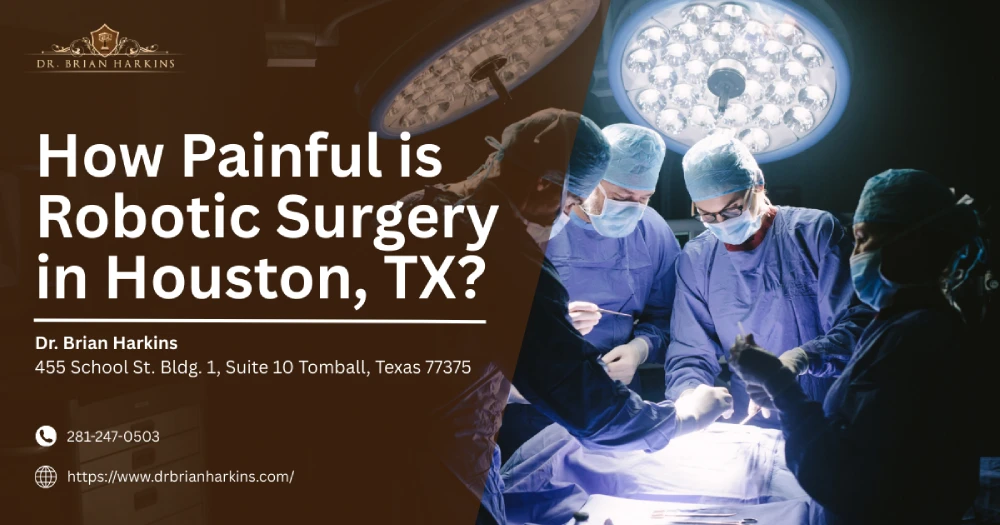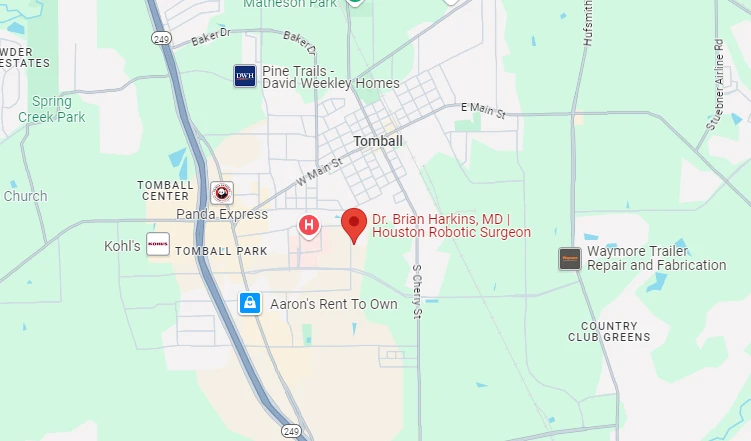
Robotic surgery in the Houston area generally results in less postoperative pain and faster recovery times than traditional open surgery or even standard laparoscopic procedures. By combining a state-of-the-art da Vinci® Surgical System with the steady hands of an experienced surgeon, this minimally invasive approach uses small incisions, high-definition 3D vision, and wristed robotic instruments that move with a greater range of motion than the human wrist. The result? Less tissue trauma, reduced pain and discomfort, and better overall patient outcomes.
How painful is robotic surgery in Houston, TX? Most patients report significantly less discomfort with robotic-assisted procedures compared to traditional open surgery. Whether you’re traveling from Northwest Houston, downtown Houston, or even consulting with North Texas Surgical Specialists, you probably want to know exactly how the experience feels and how long soreness will linger. Below you’ll discover why the advanced robotic platform hurts less, what still affects your comfort, and how to prepare for a smooth recovery. Let’s dive in.
Although robotic surgery sounds futuristic, the da Vinci surgical system has been in Houston operating rooms for two decades. The setup places your surgeon at a console where they control four robotic arms equipped with tiny, wristed tools. A 3D high-definition vision system magnifies the surgical area up to ten times, allowing almost microsurgical precision. The use of the robot reduces unintended tissue traction, which is a major trigger of pain and inflammation.
The robot’s instruments enter through tiny 8 mm ports—far smaller than the 10–20 cm incision used in traditional open surgery. Because the robotic system pivots at fixed points on the abdominal wall, it avoids stretching muscles and nerves, which directly translates into less postoperative pain and a lower risk of infection.
Pain receptors activate when tissue is cut, stretched, or swollen. Clinical studies support that minimally invasive robotic surgery reduces those triggers by limiting blood loss, decreasing internal bruising, and shortening operative time on complex procedures such as colorectal or colon surgery. Baylor St. Luke’s and Houston Methodist data show average day-one pain scores of 2–3/10 after robotic hernia repair compared with 5–6/10 for traditional surgery.
| Pain & Recovery Metric | Robotic Surgery | Laparoscopic (Non-robotic) | Open Surgery |
|---|---|---|---|
| Typical Incision Size | 0.8 cm × 4 ports | 1 cm × 3 ports | 10–20 cm single cut |
| Day-1 Pain Score (0–10) | 2–4 | 3–5 | 5–7 |
| Opioid Use Beyond Day 3 | < 20 % of patients | 35 % | 60 % |
| Average Hospital Stay | 1–2 days | 2–3 days | 4–6 days |
| Return to Desk Work | 7–10 days | 10–14 days | 21–28 days |
A hernia repair, gallbladder removal, prostatectomy, or colorectal resection each involve different internal dissection. More suturing or organ manipulation typically means more temporary discomfort, even with a minimally invasive approach.
Non-smokers, regular exercisers, and patients with healthy weight often experience less pain and quicker recovery. Chronic pain conditions, opioid tolerance, anxiety, or diabetes can all heighten pain perception. Share these details so your care team can personalize medication strategies.
Skill matters. Look for leaders in robotic surgery—surgeons who perform hundreds of robotic cases annually and actively publish outcome data. Ask about conversion-to-open rates, ERAS adherence, and whether the team uses a da Vinci Vision System with 3D high-definition views for optimal accuracy.
While no surgery is completely pain-free, patients undergoing robotic-assisted procedures in Houston generally experience milder, more manageable discomfort. Thanks to smaller incisions, less tissue trauma, and precise surgical control, most report soreness or a dull ache rather than sharp pain. Many transition to over-the-counter pain medication within 48–72 hours.
Most insurers treat the robotic approach the same as traditional surgery. If your policy approves the underlying procedure—hernia repair, colon surgery, hysterectomy—the robotic technique is usually included. Always verify pre-authorization with your carrier for clarity on co-pays or deductibles.
No. Anesthesia and prescription pain medication impair reflexes for at least 24 hours. Arrange a responsible adult to drive you home and stay the first night to assist with mobility, medication timing, and observation for potential complications.
Higher BMI can lengthen operative time and gas absorption, mildly increasing early discomfort. However, the articulation of the da Vinci robotic arms often makes complex procedures in heavier patients easier and safer than open surgery, resulting in similar pain levels by day 3.
Robotic-assisted surgery uses a robotic system that filters tremor and provides 3D high-definition magnification, while conventional laparoscopy relies solely on straight, rigid instruments and 2D monitors. The robotic platform’s wristed tools offer greater articulation, enabling more precise suturing and dissection, which can translate into reduced pain and quicker return to normal activities.
Yes. Advanced robotic techniques allow precise dissection deep within the pelvis, preserving nerves and blood supply. Clinical studies support lower conversion-to-open rates and faster gastrointestinal recovery compared with open colon surgery. Discuss staging, tumor location, and surgeon experience to confirm you’re an ideal candidate.
Many surgeons recommend a lightweight abdominal binder for one to two weeks after robotic hernia repair. The gentle compression stabilizes the repair, reduces swelling, and can lessen pain and discomfort while coughing or moving. Wear it during waking hours and remove at night unless otherwise directed.
Smaller incisions mean fewer entry points for bacteria, and the enclosed surgical field limits exposure. Combined with shorter hospital stays, robotic surgery offers a measurable reduction in surgical-site infections compared with traditional open surgery, according to multiple peer-reviewed studies of general surgeons nationwide.
Most robotic surgical procedures, including gallbladder or colorectal operations, require general anesthesia to keep you completely still and pain-free. An anesthesiologist monitors vital signs and adjusts medications via an intravenous line, ensuring you remain asleep and comfortable throughout your time in the operating room.
Light walking starts the day of surgery, but wait two weeks before strenuous workouts. Most patients resume low-impact cardio at week 3 and unrestricted activity by week 6, pending surgeon approval. Adhering to this timeline reduces risk of hernia recurrence or wound complications.


Dr. Brian Harkins is a renowned surgeon specializing in advanced, minimally invasive, and robotic surgical techniques. With a dedication to innovation and personalized patient care, he has transformed countless lives by delivering exceptional outcomes.

I want a website like this, where do i start?